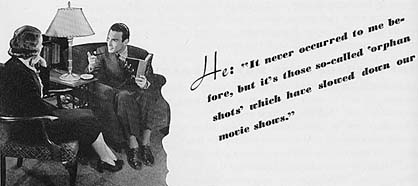from: How to Make Good Home Movies (1958)
What is an orphan film?
Narrowly defined, it's a motion picture abandoned by its owner or caretaker. More generally, the term refers to all manner of films outside of the commercial mainstream: public domain materials, home movies, outtakes, unreleased films, industrial and educational movies, independent documentaries, ethnographic films, newsreels, censored material, underground works, experimental pieces, silent-era productions, stock footage, found footage, medical films, kinescopes, small- and unusual-gauge films, amateur productions, surveillance footage, test reels, government films, advertisements, sponsored films, student works, and sundry other ephemeral pieces of celluloid (or paper or glass or tape or . . . ).
For examples, visit the National Film Preservation Foundation, an institution dedicated to saving orphan films.
The "Orphans of the Storm" symposium embraces the broader definition of this new rubric in film preservation and seeks to bring together scholars, artists, archivists, collectors, curators, conservators and enthusiasts who recognize the Orphic value of these neglected aspects of our collective visual culture.
How to speak Orphan
Dictionaries suggest at least three connotations of "orphan," each of which points to problems in the survival of films.
orphan
1. one deprived of protection or advantage (orphans of the
storm).
His outtakes, like his mother's home movies, deteriorated because no
archive would store or preserve them.
orphan
2. an item not developed or marketed because its limited use makes
it unprofitable (an orphan drug).
Charles Burnett's "Killer of Sheep" became an orphan film
for twenty years because no distributor would pick up this challenging
work.
orphan
3. a discontinued model (an orphan automobile).
The aviatrix recorded some remarkable aerial footage, but she found
herself with a set of orphan films when no lab would develop her 9.5mm
footage.
Gregory Lukow, in his 1999 address to "Orphans of the Storm I," evaluated the impact of the "orphan film" metaphor.
Steve Leggett of the National Film Preservation Board has located a use of the term "orphan film" as early as 1992.
Paolo Cherchi-Usai of the George Eastman House in his 1999 keynote address, "What is an Orphan Film?" credited David Francis with introducing the term during 1993 hearings for the National Film Preservation Plan.
Elizabeth Farnsworth on PBS's "The News Hour" broadcast a report, "Saving Orphan Films," on January 12, 2001.


